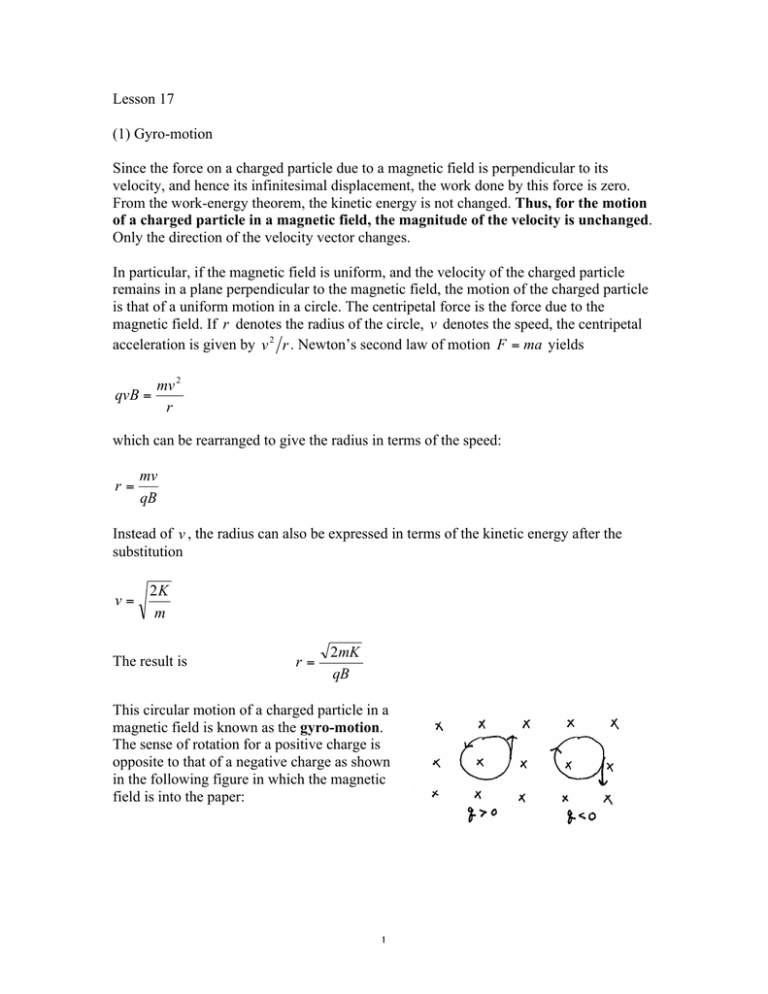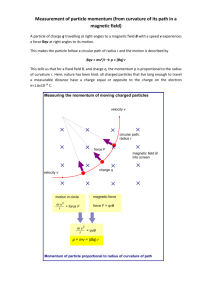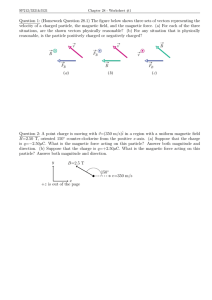Lesson 17 (1) Gyro-motion Since the force on a charged particle due
advertisement

Lesson 17 (1) Gyro-motion Since the force on a charged particle due to a magnetic field is perpendicular to its velocity, and hence its infinitesimal displacement, the work done by this force is zero. From the work-energy theorem, the kinetic energy is not changed. Thus, for the motion of a charged particle in a magnetic field, the magnitude of the velocity is unchanged. Only the direction of the velocity vector changes. In particular, if the magnetic field is uniform, and the velocity of the charged particle remains in a plane perpendicular to the magnetic field, the motion of the charged particle is that of a uniform motion in a circle. The centripetal force is the force due to the magnetic field. If r denotes the radius of the circle, v denotes the speed, the centripetal acceleration is given by v 2 r . Newton’s second law of motion F = ma yields qvB = mv 2 r which can be rearranged to give the radius in terms of the speed: r= mv qB Instead of v , the radius can also be expressed in terms of the kinetic energy after the substitution v= 2K m The result is r= 2mK qB This circular motion of a charged particle in a magnetic field is known as the gyro-motion. The sense of rotation for a positive charge is opposite to that of a negative charge as shown in the following figure in which the magnetic field is into the paper: 1 Example: Find the radius of the gyro-motion for a 1-eV electron in a magnetic field of 10-4T. 2 !1!1.6 !10 "19 != = 5.9 !10 5 m / s 31 9.1!10 9.1 × 10 −31 × 5.9 × 10 5 r= = 0.03m = 3cm 1.6 × 10 −19 × 10 −4 In many applications, the charged particle acquires its speed through acceleration by a potential difference. If ΔV is the potential difference, the kinetic energy after acceleration is given from energy conservation as K = qΔV The velocity is then != 2K 2q!V = m m Substituting this into the formula for the radius of the orbit, r= m 2qΔV 1 = q m B m q 2ΔV B In the following, we discuss a number of applications of the gyro-motion. (2) Measurement of e m for electrons. Applying the above formula for the gyro-radius to electrons, and solving for the ratio q m = e / me , we find e 2ΔV = me (Br )2 In 1897, J.J. Thomson in England succeeded in measuring e me using this relation, and was credited for the discovery of electrons, demonstrating the corpuscular nature of the beams observed in discharge tubes, which are tubes with high vacuum fitted with electrodes maintained at high voltage, one of which can emit electrons. 2 (3) Mass Spectrometer The formula for the gyro-radius can be applied to the following schematic setup, in which ions from a source are accelerated through a potential difference before entering a region of uniform magnetic field, and are detected after traversing a semicircular path. If there is a mixture of ions of different masses all with the same charge coming from the source, they are detected at different locations because the radius of the path is proportional to the square root of the mass. From the location of detection, it is possible to calculate the mass of the ion and identify its nature. Such an apparatus is called a mass spectrometer (4) Isotope Separation The uranium isotope U 235 can undergo fission but the dominant isotope U 238 (natural abundance 99.3%) found in nature does not. If the atoms of U 235 and U 238 are made into ions with the same charge, they can be separated using a similar setup as the mass spectrometer. This method of isolating U 235 was one of the methods employed during the Second World War for the production of fissile materials for atomic bombs. (5) Cyclotron The period of rotation of the gyro-motion is T= 2! r 2! mv 2! m = = " " qB qB and the frequency is f = 1 qB = T 2πm It is remarkable that the period and frequency do not depend on the velocity of the particle or radius of the path, although the radius increases as the velocity increases. This aspect of the gyro-motion is exploited in the device called the cyclotron, which is a kind 3 of charged particle accelerator invented by Lawrence. The device consists of two halves of a “pill box”, known as the dee’s, placed in vacuum and connected to an alternating voltage source that keeps one dee at a higher potential than the other for one half period, and does the reverse in the next half period. In this way, the direction of the electric field in the gap between the dees also alternates. The dees are also immersed in a uniform magnetic field directed perpendicularly to them. A source of ions is provided at the center. These ions are accelerated as they enter the gap, and go into circular orbits with a fixed period given above. If the period of the voltage source is set equal to the period of motion, we can arrange the charge particles to experience an electric field in the same direction as its motion for each crossing of the gap. In this way, the speed of the particles will continue to increase, and so does the radius of the orbit. When enough speed is acquired, the magnetic field can be switched off to allow the particle to emerge. Example: Using a magnetic field of 0.1T, what is the minimum radius of the dees to produce 1MeV protons? What is the required frequency for the voltage source? Solution: The minimum radius is the radius of a proton with 1MeV kinetic energy, and is given by r= 2mK = qB 2 × 1.67 × 10 −27 × 10 6 × 1.6 × 10 −19 = 1.4m 1.6 × 10 −19 × 0.1 The frequency is qB 1.67 × 10 −19 × 0.1 f = = = 1.6 × 10 6 Hz = 1.6MHz − 27 2πm 2π × 1.67 × 10 4 (6) Confinement of Charged Particles by Magnetic Field In order for the path of a charged particle in a uniform magnetic field to be a circle, the particle must be introduced into the region of the magnetic field with its velocity perpendicular to the field. In this case, the velocity has zero component along the field. If the component is nonzero, it will maintain the same value because the magnetic force on the particle has no component along the magnetic field. Since the magnitude of the velocity does not change, neither will the magnitude of the component of the velocity on the plane perpendicular to the magnetic field, which we shall denote by v ⊥ , The particle will then follow a helical path ( a spiral), with the radius given by r= m! ! qB If this radius is small, the particle will appear to be tied to a magnetic field line. If the field line is a closed curve, the particle is confined, because it will not wander off from the field line. In the ongoing research of fusion, the purpose of which is to produce energy from similar processes by which the sun makes energy, namely, fusion of nuclei, gases have to heated to temperatures as high as hundreds of millions of degree. Such gases clearly cannot be contained in material containers. At such temperatures, a gas is completely ionized, and is composed of positively charged ions and electrons, forming a state called a plasma. It then is possible to confine the plasma using a strong magnetic field whose field lines are closed curves. One of the varied approaches to the magnetic confinement of plasma is a device called the tokamak, in which the plasma is confined in a donut shaped volume with strong magnetic field. The General Atomic Company here in San Diego houses one of the largest such devices in the world. From the kinetic theory of gases, the average kinetic energy of a single atom in a monatomic gas at a temperature of T (K ) is given by K= 3 kT 2 where k = 1.38 × 10 −23 J K is Boltzmann’s constant. At T = 10 8 K , this gives K = 2.1× 10 −15 J (= 1.3keV ) . If the strength of the confinement magnetic field is 2T, and the confined ions are deuterium nuclei, with a charge of e and a mass approximately twice that of a proton, the gyro-radius is only 3.6mm. Thus, the ion is very tightly tied to the field line. 5 Confinement by magnetic field also takes place in the upper atmosphere known as the ionosphere, where charged particles from the sun are trapped by the earth’s magnetic field, and are responsible the occurrence of aurora. (7) Motion in Combined Electric and Magnetic Fields When both electric and magnetic fields are present, the force on a charged particle is given by F = q E+v×B ( ) which is known as the Lorentz force. Consider a simple case where the electric and the magnetic fields are both uniform and are perpendicular to each other, with the electric field pointing downward and the magnetic field pointing into the paper as shown: For a positive charge moving in the direction of the black arrow, the force due to the electric field is downward, while the force due to the magnetic field is upward. In general these forces do not cancel, and the charged particle will experience an acceleration that is either upward or downward, depending whether the electric or the magnetic force is stronger. Cancellation will occur when the velocity of the particle is just right. The value of this velocity is given by qE = q! B Or, ! = E B which is independent of the charge and mass of the particle. The particle will travel in a straight path. This forms the basis of a device called a velocity selector. 6



